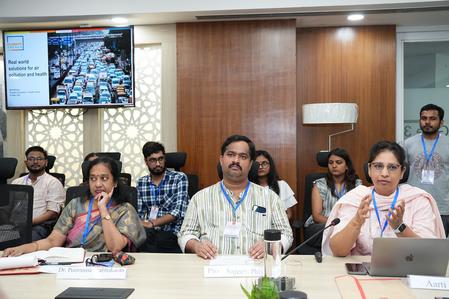Achieving 30 Pc Clean Air Targets Can Reduce Nationwide Disease Prevalence
The launch took place at a consultation workshop here to kickstart the air quality and public health discussion as the monsoon season comes to an official end.
The dashboard, a first-ever one-of-a-kind tool, is based on indigenous fifth National Family Health Survey (NFHS-5) data set across 641 Indian districts, has been designed to demonstrate associations between PM2.5 air pollution levels and diseases such as hypertension, heart disease, chronic obstructive pulmonary disease (COPD), anaemia, and diabetes among women of reproductive age between 15 and 49; as well as anaemia, low birth weight, and lower respiratory infections among children under the age of five.
Virinder Sharma, Technical Member, Commission for Air Quality Management in Delhi-NCR (CAQM), said, "One issue is that the numbers are shocking, but abstract. They are not connected with people directly. The impacts feel distant, like climate change -- something in the future, gradual, especially in terms of morbidity. People do not see the impacts immediately."
"There's no "death certificate" for air pollution. Losses are happening -- whether in Delhi-NCR hospitals, workplaces, or through shortened lifespans -- but the crisis is silent, invisible, and diffuse. It is easy to underestimate unless it is connected to people's lived reality."
The health co-benefits of clean air are observed to be greatest in densely populated, high-burden states in the north and eastern parts of the country.
Among women of reproductive age, the prevalence of diabetes is currently 1.7 per cent, which could drop to 1.4 per cent if the PM2.5 reduction targets were met.
Meanwhile, the decline in the prevalence of lower respiratory infections, low birth weight and anaemia are most pronounced among children in regions with high baseline prevalence of severe air pollution, particularly the Indo-Gangetic Plain and eastern states.
The clean air scenario was modelled assuming 30 per cent reduction in PM2.5 concentrations based on NCAP's 2024 target, with the aim of helping policymakers and researchers with real-world health impact data as the severe air pollution months approach.
Aarti Khosla, Climate Trends Director, said, "The central concern for air quality mitigation should be public health. Over the past 10 years, as air quality became more of a scientific issue and increasingly linked with aspects like climate change, it has somewhat moved away from its social dimension as a public health concern primarily."
"I think bringing it back to where it belongs is critical. That is why all the studies on epidemiological evidence and research conducted in India are so important for establishing clear links between air quality and public health."
The Health Dashboard has been designed using Census 2011 district boundaries, taking district-level prevalence rates for each morbidity indicator and PM2.5 values extracted from IIT Delhi's Satellite-Based Application For Air Quality Monitoring and Management at National Scale (SAANS) satellite data.
She also added, "We are at the beginning of the winter period. There is going to be heightened coverage on air pollution. I hope this is also the moment to move beyond quick fixes and cosmetic changes, and instead talk about the real opportunities before us."
Sagnik Dey, Chair Professor in Policy Studies, Centre for Atmospheric Sciences at IIT Delhi, said, "We realised that we are conducting research, but often this science is not communicated to policymakers in the way it should be, and particularly not to citizens."
"That is where we partnered with Climate Trends, mainly to help us in using the science to create a strong health-centric narrative. The idea is that, at the end of the day, the message should reach the public, and eventually, we can have a more effective way to involve everyone as part of the solution."

Legal Disclaimer:
MENAFN provides the
information “as is” without warranty of any kind. We do not accept
any responsibility or liability for the accuracy, content, images,
videos, licenses, completeness, legality, or reliability of the information
contained in this article. If you have any complaints or copyright
issues related to this article, kindly contact the provider above.
Most popular stories
Market Research

- Bydfi Highlights 'BUIDL' Ethos During Newcastle United Match Against Arsenal
- Solotto Launches As Solana's First-Ever Community-Powered On-Chain Lottery
- 1Inch Becomes First Swap Provider Relaunched On OKX Wallet
- “Farewell To Westphalia” Explores Blockchain As A Model For Post-Nation-State Governance
- Yield Basis Nears Mainnet Launch As Curve DAO Votes On Crvusd Proposal
- Ethereum Meme Coin Little Pepe Crosses $25M, Announces 15 ETH Giveaway






















Comments
No comment